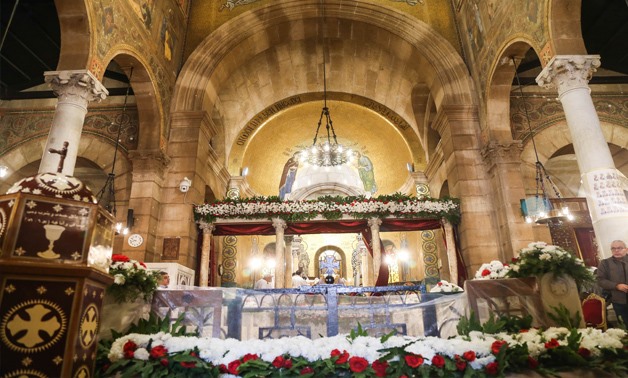
Christians gathered at Mass at St. Peter and St. Paul church attached to the St. Mark's Coptic Orthodox Cathedral to mark the first anniversary of the the church bombing, Dec.11, 2017-EgyptToday/ Mohamed El Hosary
CAIRO – 11 December 2017: Cairo Cathedral at Abbassiya district held a special mass Monday to mark the first anniversary of the martyrdom of 29 Copts at the explosion of St. Peter and St. Paul church, which are attached to St. Mark's Coptic Orthodox Cathedral.
Families and friends of victims as well as survivors are gathered for the first anniversary of the church bombing.
 Christians gathered at Mass at St. Peter and St. Paul church attached to the St. Mark's Coptic Orthodox Cathedral to mark the first anniversary of the the church bombing, Dec.11, 2017-EgyptToday/ Mohamed El Hosary
Christians gathered at Mass at St. Peter and St. Paul church attached to the St. Mark's Coptic Orthodox Cathedral to mark the first anniversary of the the church bombing, Dec.11, 2017-EgyptToday/ Mohamed El Hosary
Police forces have intensified security measures at the church’s gates and prevented the entrance of anybody without an invitation to attend the service.
On December 11, 2016, an explosion hit the small church of St. Peter and St. Paul attached to the St. Mark's Coptic Orthodox Cathedral during the Sunday mass, killing 29 Copts and injuring many others, the majority of which are women and children.
 Christians gathered at Mass at St. Peter and St. Paul church attached to the St. Mark's Coptic Orthodox Cathedral to mark the first anniversary of the the church bombing, Dec.11, 2017-EgyptToday/ Mohamed El Hosary
Christians gathered at Mass at St. Peter and St. Paul church attached to the St. Mark's Coptic Orthodox Cathedral to mark the first anniversary of the the church bombing, Dec.11, 2017-EgyptToday/ Mohamed El Hosary
The blast was caused by the 22-year-old terrorist, Mahmoud Shafiq Mohamed Mostafa, who used an explosive belt to blow himself up in the church.
.jpg) Christians gathered at Mass at St. Peter and St. Paul church attached to the St. Mark's Coptic Orthodox Cathedral to mark the first anniversary of the the church bombing, Dec.11, 2017-EgyptToday/ Mohamed El Hosary
Christians gathered at Mass at St. Peter and St. Paul church attached to the St. Mark's Coptic Orthodox Cathedral to mark the first anniversary of the the church bombing, Dec.11, 2017-EgyptToday/ Mohamed El Hosary
Since then, the Interior Ministry arrested seven terrorists responsible for the accident who were involved in hiding explosive materials and explosive belts, and in promoting Takfiri ideas on the social media.
 Christians gathered at Mass at St. Peter and St. Paul church attached to the St. Mark's Coptic Orthodox Cathedral to mark the first anniversary of the the church bombing, Dec.11, 2017-EgyptToday/ Mohamed El Hosary
Christians gathered at Mass at St. Peter and St. Paul church attached to the St. Mark's Coptic Orthodox Cathedral to mark the first anniversary of the the church bombing, Dec.11, 2017-EgyptToday/ Mohamed El Hosary
Since President Mohammed Morsi was ousted in 2013, Egypt has faced many terrorist attacks, trying to destabilize Egypt and cause chaos, but Security forces have exerted immense efforts to combat terrorism in Egypt.
Besides the attack on St. Peter and St. Paul church, the first blast took place on a Palm Sunday service on April 9 at St. George's Church in Tanta, killing at least 27 and wounding 78 others due to an explosive device that was planted under a seat in the main prayer hall.
At the same time, a suicide bomber attacked St. Mark's Coptic Orthodox Cathedral in Alexandria where Pope Tawadros II held the Palm Sunday mass. Two of the Police officers who have been guarding the church stopped a man wearing an explosive belt. Two of those officers, a man and a woman, were killed, along with civilians and other police staff.
Responding to these attacks and trying to uproot terrorism from Egypt, President Abdel Fatah al-Sisi declared a three-month state of emergency after the two deadly bombings that targeted the Coptic Christian churches on Palm Sunday.
The country also formed a Supreme Council to counter terrorism and extremism.
A month after Tanta and Alexandria’s attacks, another terrorist attack took place on May 26 when three vehicles blocked the way of Christians heading to St Samuel the Confessor Monastery in Maghagha, and opened fire.
In response to that attack, the Egyptian military launched airstrikes against what were said to be militant training facilities in Libya.
The most recent attack on worship places in Egypt is the Al-Rawdah mosque attack. According to eyewitnesses, the 30 terrorists had initially come out riding all-terrain vehicles, which they ditched 150 meters away from the mosque. They then set off a bomb in the vicinity of the mosque, and started opening fire at the worshippers inside and outside the mosque. The attackers gunned down the trapped worshipers in a horrific 20 minute massacre. They also targeted ambulances at the crime scene and set cars nearby ablaze.
A few hours later, the Egyptian Air Forces launched airstrikes, targeting terrorist hideouts in mountain areas near the Arish attack scene. The attacks destroyed a number of pickups used in the attacks and killed the “terrorists” on board, according to an official statement by army spokesman Tamer el-Refaie.
Other “terrorist hotbeds” were also discovered and targeted by the Air Force and forces on the ground in North Sinai, the statement read.
A total of 30 “terrorists” were also killed in a raid on the Risan town of Central Sinai hours earlier, a security source told Sky News Arabia.



.jpg)

Comments
Leave a Comment